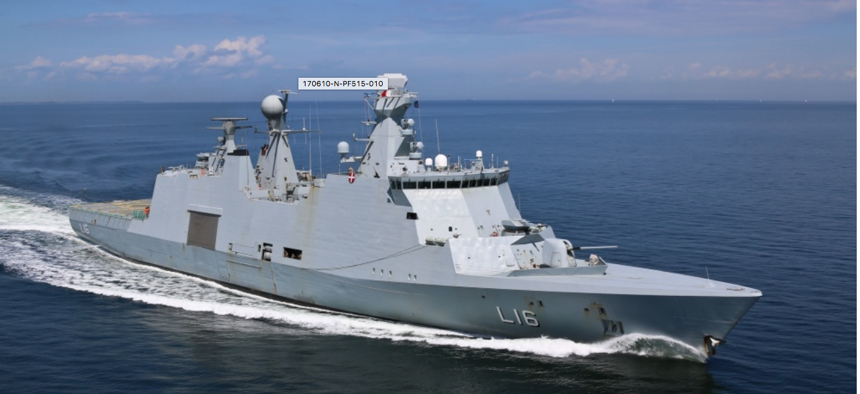
The Danish Absalon-class combat support ship HDMS Absalon (L16) transits the Baltic Sea during exercise BALTOPS 2017, June 10. Chief Petty Officer America Henry Navy Media Content Services
It’s Time for NATO to Look North
The alliance’s six-year old maritime strategy quickly needs updating for the new (and more Russian) age.
Now that President Donald Trump finally has endorsed Article 5 of the NATO Treaty, putting minds on both sides of the Atlantic more at ease, it’s time for the alliance to get to work. In addition to focusing on defense spending, counterterrorism, and enhanced deterrence against Russia, when Defense Secretary Jim Mattis and his counterparts gather in Brussels this week NATO should shift its focus to a region largely ignored since the end of the Cold War: The North Atlantic.
Why the North Atlantic? Russian activity in the North Atlantic, specifically, the space between Greenland, Iceland, and the UK – the GIUK Gap -- has steadily increased over the last few years to a level unseen since the end of the Cold War. In fact, Russia’s 2015 maritime doctrine specifies the Atlantic Ocean as a region for potential conflict, so it shouldn’t be surprising that they are placing extra focus there. Retired Adm. Mark Ferguson, the US’s former top Navy commander in Europe, said in 2016 that he had witnessed the intensity of Russian submarine patrols rise by an astounding 50 percent over the previous year, with an emphasis on speed and strategic surprise. Additionally, last fall, Russia tested a nuclear-capable unmanned underwater vehicle designed to create “wide areas of radioactive contaminations rendering them unusable for military, economic, or other activity.” We might not see this weapon ready for use until the mid-2020s but the fact that it was tested should be enough for NATO’s internal alarms to start blinking red.
Unfortunately, NATO is woefully unprepared to cope with these types of challenges. Since the early 2000s until today, the NATO alliance has dealt almost exclusively with conflicts on the ground and in the air: from the war in Afghanistan to the ousting of Gadhafi in Libya to the now-frozen conflict in Eastern Ukraine. As a result, the Alliance’s maritime strategy, know-how, and capabilities have atrophied. Although some maritime activities like counter-piracy and migration assistance in the Mediterranean Sea fall under NATO’s purview, these missions pale in comparison with NATO’s other missions over the last 25 years. An effective North Atlantic maritime strategy requires a fundamental shift in thinking for the Alliance.
It also requires a change in strategy and acquisition policy for individual NATO allies, particularly those bordering the North Atlantic. Unfortunately, many NATO allies have allowed their maritime capabilities in the region to wane over the last two decades. Earlier this year, five senior retired members of the British Royal Air Force warned that the UK’s lack of planes to hunt Russian subs in the North Atlantic has left their Trident nuclear deterrent vulnerable to Russian spying. NATO’s Atlantic facing members also possess far fewer capabilities than they did 20 years ago. In 1995, they had around 100 frigates, but today that number hovers at about 50. The United States, for example, has shifted most of it 52 attack submarines to the contested Asia Pacific region.
There is some good news, though. The United States is returning to fly P-8 Poseidon patrol aircraft out of Naval Air Base Keflavik in Iceland, which was closed back in 2006. Norway has also announced the purchase of new submarines and is expanding its maritime patrol aircraft fleets. While it is notable that individual countries are now beginning to realize the importance of the North Atlantic, there are steps that NATO should take to place more long-term focus and alliance-wide capabilities throughout this region.
NATO must revise its maritime strategy, which was last updated in 2011. This won’t be easy; it would require buy-in from members who might not feel as immediately affected by challenges in the North. But an updated strategy would reorient the alliance toward maritime challenges and address the full spectrum of naval challenges rather than just the lower-end operation found in the 2011 version. The new strategy should also ensure that no single ally bears the burden of providing the entirety of certain assets for the region; provide clarity on which type of naval attacks are considered escalatory; and stress the importance of partnering with the private sector to address cyber threats and vulnerabilities presented by undersea cables.
We must remember, though, any new strategic attention on the North Atlantic should not come at the expense of a comprehensive Europe-wide strategy. Southern and eastern allies will continue to face major challenges for the foreseeable future, including mass migration, instability in the Middle East, and hybrid threats from Russia in Eastern Europe. The alliance must be able to simultaneously and effectively address a wide range of threats from north to south and east to west, and on air, land, and sea. NATO has proven its ability to adapt since its creation in 1949, and it must do so once again.




